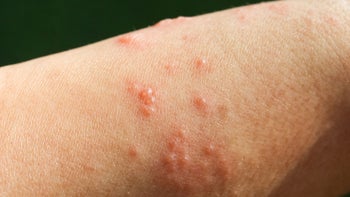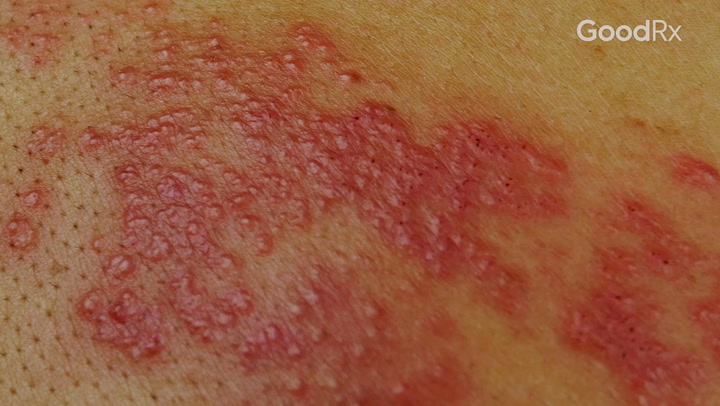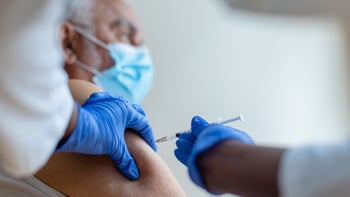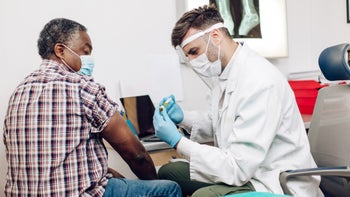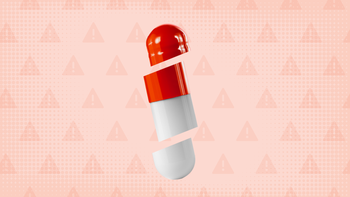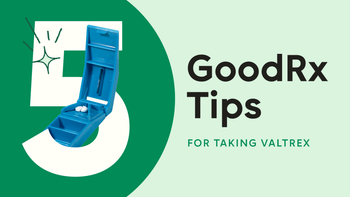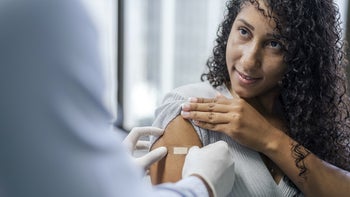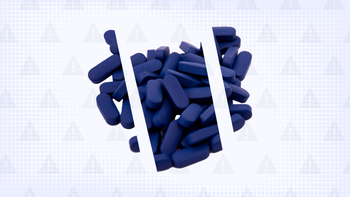
Valacyclovir vs. Acyclovir: Which Is Better for Shingles?
Key takeaways:
Valacyclovir (Valtrex) and acyclovir are antiviral medications used to treat shingles. They can help your skin heal and reduce the pain caused by shingles.
Valacyclovir and acyclovir are taken by mouth multiple times a day. But acyclovir needs to be taken more frequently since it’s not absorbed as well as valacyclovir.
In general, one medication isn’t recommended over the other. But valacyclovir requires fewer pills. Your prescriber will determine which is best for you.
Access savings on related medications
Table of contents

If you're 50 or older, you’ve probably started hearing more about shingles (herpes zoster), a painful skin rash from the virus that causes chickenpox. That’s because you’re more likely to develop shingles at this age.
The good news is there’s a vaccine that can lower your risk of developing shingles. And you’re eligible to get it once you turn 50. But if you’re one of the roughly 33% of adults who end up with shingles, there are a few medications available to treat it.
Valacyclovir (Valtrex) and acyclovir are two treatment options for shingles. These medications may sound similar, but they’re not the same.
SHINGRIX (Zoster Vaccine Recombinant, Adjuvanted) is now $0 for almost everyone*
Get SHINGRIX at the pharmacy or in-network doctor’s office today. 98% of privately insured people pay $0 and all Medicare Part D beneficiaries pay $0 at the pharmacy.
Prescribing Information
*Coverage and cost may vary and are subject to change without notice. Reimbursement decisions are made by individual insurance plans.


SHINGRIX is an FDA-approved vaccine for the prevention of shingles (herpes zoster) in adults 50 years and older. SHINGRIX is not used to prevent chickenpox.
• You should not receive SHINGRIX if you are allergic to any of its ingredients or had an allergic reaction to a previous dose of SHINGRIX
• An increased risk of Guillain-Barré syndrome (severe muscle weakness) was observed after vaccination with SHINGRIX
• Fainting can happen after getting injectable vaccines, including SHINGRIX. Precautions should be taken to avoid falling and injury due to fainting
• The most common side effects are pain, redness, and swelling at the injection site, muscle pain, tiredness, headache, shivering, fever, and upset stomach
• SHINGRIX was not studied in pregnant or nursing women. Tell your healthcare provider if you are pregnant, plan to become pregnant, or are breastfeeding
• Vaccination with SHINGRIX may not protect all individuals
• Ask your healthcare provider about the risks and benefits of SHINGRIX. Only a healthcare provider can decide if SHINGRIX is right for you
You are encouraged to report vaccine adverse events to the US Department of Health and Human Services. Visit www.vaers.hhs.gov to file a report, or call 1-800-822-7967.
For US audiences.
Trademarks are property of their respective owners.
©️2024 GSK or licensor.
PMUS-SGXWCNT240015 May 2024
Produced in the USA.
GoodRx Health information and resources are reviewed by our editorial staff with medical and healthcare policy and pricing experience. See our editorial policy for more detail. We also provide access to services offered by GoodRx and our partners when we think these services might be useful to our visitors. We may receive compensation when a user decides to leverage these services, but making them available does not influence the medical content our editorial staff provides.
So, how exactly are they different? And is one better than the other? Below we’ll discuss what you should know about valacyclovir versus acyclovir for treating shingles.
What is valacyclovir?
Valacyclovir is a prescription medication that’s FDA approved to treat a few conditions caused by viruses. This includes shingles, genital herpes, and cold sores in adults. In children, it’s approved to treat chickenpox and cold sores.
Valacyclovir is available as an oral tablet in two doses: 500 mg and 1,000 mg (1 g). You can find it both as brand-name and generic products.
What is acyclovir?
Acyclovir is also a prescription antiviral medication. The oral tablet, capsule, and liquid forms are FDA-approved to treat shingles, genital herpes, and chickenpox in adults. They can also treat chickenpox in children.
When treating shingles, you can find acyclovir in the following doses and dosage forms, which are available as generic products:
Tablets: 400 mg and 800 mg
Capsules: 200 mg
Oral suspension: 200 mg/5 mL
How is shingles treated? Our guide explains the medications, pain relief options, and home remedies that help treat shingles.
The shingles vaccine: Shingrix is recommended for adults ages 50 and older. Learn everything you need to know, including the side effects, cost, and safety.
What is it like to get shingles? One woman explains what she wishes she knew before she experienced shingles.
How do valacyclovir and acyclovir work for shingles?
Valacyclovir and acyclovir both work against varicella zoster — the virus that causes shingles (and chickenpox). They do this by interfering with the virus’s DNA. DNA is necessary for the virus to make copies of itself.
The difference is that valacyclovir is a prodrug of acyclovir. That means it’s converted into acyclovir (the active component) in the liver after being absorbed in your gastrointestinal tract (the stomach and intestines). Valacyclovir is formulated this way to help more acyclovir reach your bloodstream. That’s because acyclovir is poorly absorbed when taken on its own.
Keep in mind that valacyclovir and acyclovir won’t cure shingles. But by stopping the virus from copying itself, they can prevent it from spreading throughout your body.
How are valacyclovir and acyclovir taken for shingles?
Valacyclovir and acyclovir have different dosage schedules for shingles. Since acyclovir isn’t absorbed as well as valacyclovir, it has to be taken more frequently. Here’s how they compare.
Medication | Dosage schedule | Length of treatment |
|---|---|---|
Valacyclovir | 1 g by mouth 3 times a day | 7 days |
Acyclovir | 800 mg by mouth every 4 hours, 5 times a day | 7-10 days |
You can take valacyclovir and acyclovir with or without food. If they upset your stomach, try taking them with meals or a snack. For both medications, your recommended dosage may be lower if you have kidney problems.
How effective are valacyclovir and acyclovir for shingles?
Valacyclovir and acyclovir are both effective shingles treatments if you start taking them within 72 hours of getting the shingles rash. They can help make your skin rash and pain go away more quickly.
But evidence suggests that valacyclovir may work faster than acyclovir to resolve pain. One study showed that pain resolved in an average of 38 days with valacyclovir. This was compared to 51 days with acyclovir. There were no significant differences in skin healing between the two medications.
In general, one medication isn’t recommended over the other. But if you want to take fewer pills, valacyclovir is taken less frequently. Your prescriber will determine which option is best for you.
What are the known side effects of valacyclovir and acyclovir?
The side effects of valacyclovir and acyclovir are very similar. They’re also usually mild and resolve on their own. See the most common side effects from a head-to-head study compared below.
Side effect | Valacyclovir (7-day course) | Acyclovir (7-day course) |
|---|---|---|
Nausea | 16% | 19% |
Headache | 11% | 13% |
Vomiting | 9% | 8% |
Diarrhea | 7% | 7% |
Constipation | 5% | 5% |
Dizziness | 4% | 6% |
Weakness | 4% | 5% |
What are the serious side effects of valacyclovir and acyclovir?
Although rare, serious side effects are possible with valacyclovir and acyclovir. This includes hemolytic uremic syndrome (HUS) and thrombotic thrombocytopenic purpura (TTP). HUS is when you develop blood clots along with low levels of platelets (cells that help your blood clot) and kidney damage. TTP is similar, but also includes fever and neurological (brain and nervous system) effects.
TTS and HUS have occurred at doses higher than what’s usually taken for shingles. People with weakened immune systems (such as advanced HIV) and certain transplant recipients may be at higher risk.
Other serious side effects include acute kidney injury and neurological problems (such as agitation, confusion, hallucinations). These effects may be more likely to happen if you’re older, have kidney problems, or are taking higher-than-recommended doses.
What interactions do valacyclovir and acyclovir have?
Valacyclovir and acyclovir don’t have any known significant interactions with other medications.
But it’s still a good idea to give your prescriber and pharmacist your current medication list to check for potential issues. For example, other medications that cause kidney damage may raise the risk of kidney problems from valacyclovir or acyclovir.
How to save on valacyclovir and acyclovir
Valacyclovir and acyclovir are both available as lower-cost generic medications. The average retail price of acyclovir tends to cost less than the average retail price of valacyclovir. But by using a free GoodRx discount, you can find 7-day courses of either medication for less than $10 at certain pharmacies.
Frequently asked questions
There are several over-the-counter (OTC) pain relievers that can help alleviate pain from shingles. Your pharmacist can help recommend an option that’s safe for you to use, which may include:
Nonsteroidal anti-inflammatory drugs (NSAIDs), such as ibuprofen (Advil, Motrin) and naproxen (Aleve)
Acetaminophen (Tylenol)
Topical lidocaine products, such as lidocaine patches
If OTC options aren’t helping, your healthcare team may recommend a prescription medication for relief.
No, shingles is caused by a virus, so antibiotics won’t help treat it. That’s why you’ll be prescribed an antiviral medication like acyclovir or valacyclovir. Though, if your shingles rash becomes infected by bacteria, you may be prescribed an antibiotic for that infection.
The bottom line
Valacyclovir (Valtrex) and acyclovir are effective medications for treating shingles. They work best if started within 72 hours of getting the shingles rash. Both medications have similar side effects and cost about the same with a GoodRx discount.
The biggest difference is that you have to take acyclovir more often than valacyclovir. Your prescriber will take into account your preferences and other factors to determine which is best for you.
Why trust our experts?


References
A-S Medication Solutions. (2021). Acyclovir tablets [package insert].
American Academy of Dermatology Association. (n.d.). Shingles: Who gets and causes.
Beutner, K. R., et al. (1995). Valaciclovir compared with acyclovir for improved therapy for herpes zoster in immunocompetent adults. Antimicrobial Agents and Chemotherapy.
Bhandari, J., et al. (2022). Hemolytic uremic syndrome. StatPearls.
Centers for Disease Control and Prevention. (2019). Treating shingles (herpes zoster).
DailyMed. (2020). Acyclovir suspension.
DailyMed. (2021). Acyclovir capsule.
DailyMed. (2021). Acyclovir injection.
GlaxoKlineSmith. (2021). Valtrex (valacyclovir) [package insert].
Gnann Jr., J. W., et al. (2007). Antiviral therapy of varicella-zoster virus infections. Human Herpesviruses: Biology, Therapy, and Immunoprophylaxis.
Karaman, R., et al. (2012). Prodrugs of acyclovir – A computational approach. Chemical Biology & Drug Design.
Nair, P. A., et al. (2021). Herpes zoster. StatPearls.
Saguil, A., et al. (2017). Herpes zoster and postherpetic neuralgia: Prevention and management. American Family Physician.
Stanley, M., et al. (2022). Thrombotic thrombocytopenic purpura. StatPearls.
Taylor, M., et al. (2021). Acyclovir. StatPearls.
Trachtman, H. (2013). HUS and TTP. Pediatric Clinics of North America.



